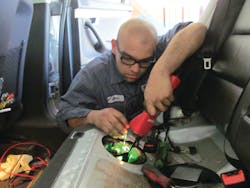The Hook, Power Probe's latest circuit tester, can now connect to systems from 12V to 48V. Power Probe's new "Smart Tip Advantage" senses the probe tip condition and selects the correct meter. The Hook also displays it's current draw in amps and its voltage threshold sets the tool to automatically turn on and display amplitude and frequency when an AC signal is detected on the tip. Other features of the Hook include: min/max voltage, current, and resistance measurements, along with peak-peak voltage, frequency counter, positive and negative pulse width and duty cycle and an isolated continuity tester.
The Review
Alex Portillo, the lead technician at Car Clinic, an auto repair facility in Mahopac, NY, has been using a Power Probe ever since he learned how to do a voltage drop test. Suffice it to say, he has grown very familiar with and attached to his Power Probe III. When he was given the new Power Probe Hook to test out, he admits at first that he was "intimidated."
"It's bigger and it has a ton of buttons on it," says Portillo. "The top button with the 'plus' sign on it supplies power and the 'negative' button below supplies ground, but what is really awesome is that when you are supplying power or ground, it tells you amperage and ohms. That just really makes the whole tool in my opinion.
"Knowing how much amperage a load is pulling helps you diagnose a lot of things. For example, if an electric motor is starting to get too much mechanical resistance, it's amperage will go up. In the past, I had to pull out an amp clamp, but not anymore.
Once familiar with the tool, Portillo determined what all of the other buttons did, and found they were simple to understand.
Other features of the Hook really stood out to the reviewer. "The Hook by default gets tripped at 20 amps, but this can be adjusted lower on components that shouldn't have 20 amps running through them, or higher if you want," says Portillo. "This really helps when you believe a fuse is blowing because of a component in a circuit, such as a defective fan, or oxygen sensor heater circuit that is drawing too much current. Instead of powering the circuit and wasting fuses, you can adjust the Hook so that its internal circuit breaker will blow. It just makes diagnostics faster.
"I also like that you can adjust voltage drop on the tool. Its default is 500mV, which is way too high. I like to see 200mV max and no more than 100mV on anything computer-related."
Among the Hook's most promising features is that it can adjust voltage. "It can be adjusted to 5V," reports Portillo. "Not coincidentally, this is the voltage level of most vehicle sensors, though not all of them. Plus, the power can be duty cycled."
He did offer a couple ideas for improvement. "I'd like to see an ability to vary voltage to any setting in the future," recommends Portillo. "I'm not an electrical engineer, so I have no clue if that's even possible.
"Also, I'd like to see the Hook grow smaller into the size of a Power Probe III. I had to jump an A/C compressor with a jumper wire and T-pin, while with an older Power Probe I can simply fit the tool where I need it. "
His verdict? "In my opinion, the professional technician needs both a Hook and classic Power Probe," says Portillo. "The Hook simply does things that no other tool does. That's why you need it."

